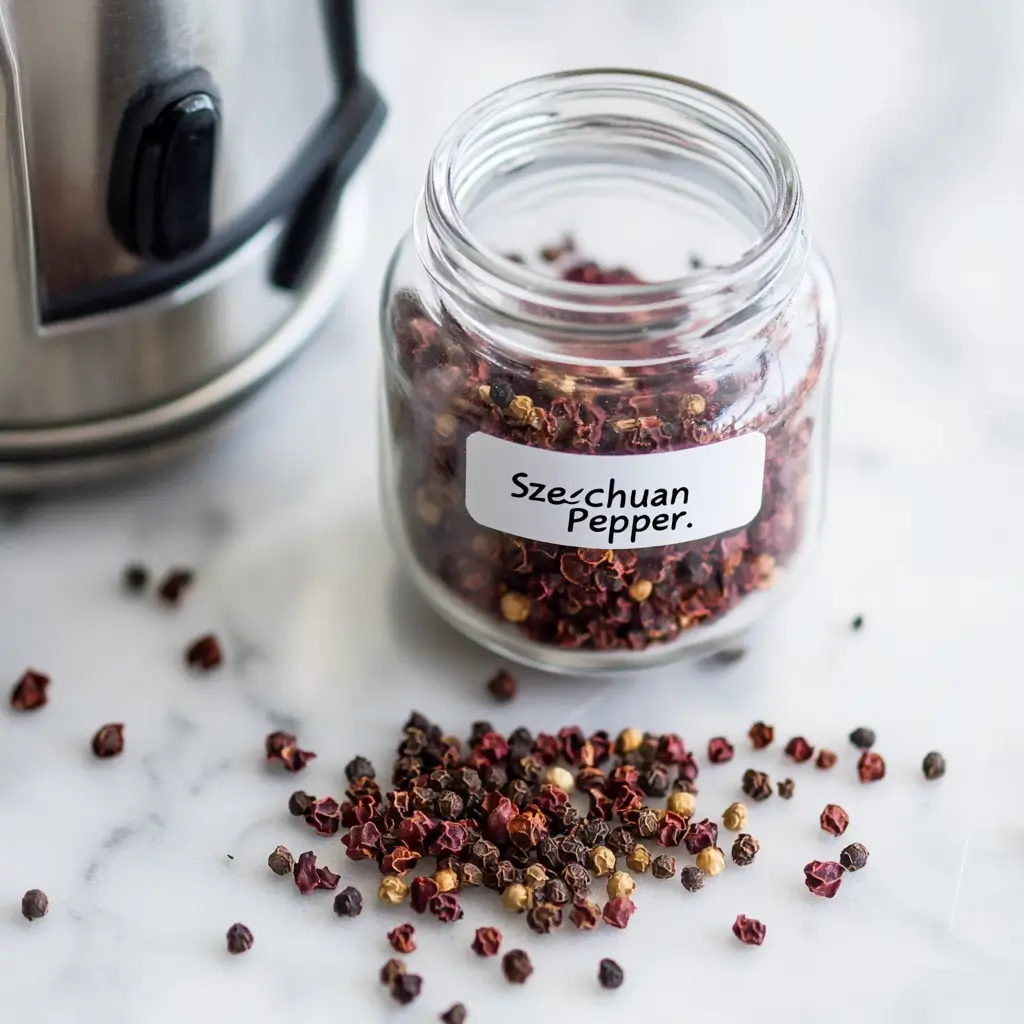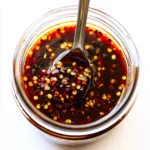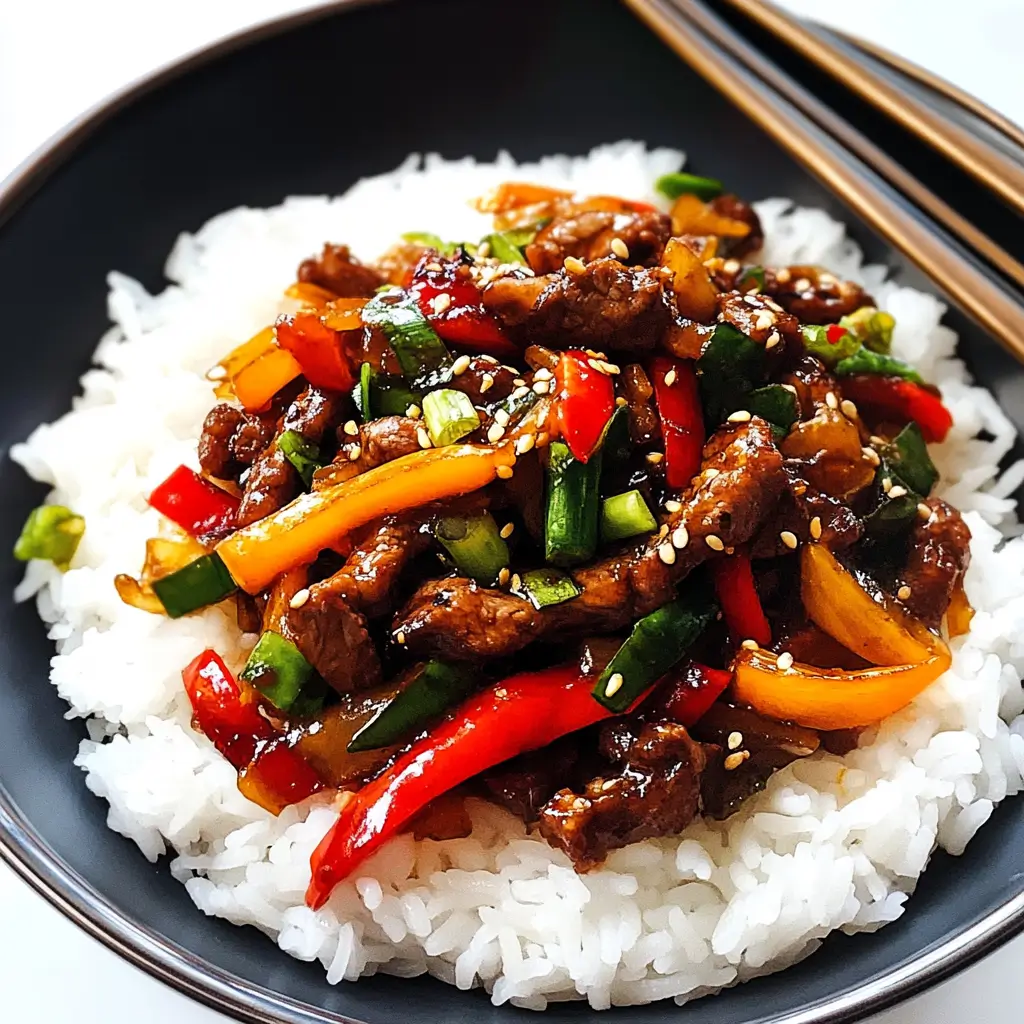If your kitchen shelf holds more hot sauces than salad dressings, then you’re in the right place. This bold and punchy Szechuan sauce is made for spice lovers who crave flavor that excites. Although many store-bought options exist, none deliver quite the same magic as a homemade batch, crafted with your preferred balance of sweet, spicy, and savory.
As a matter of fact, Szechuan sauce—sometimes spelled Sichuan—originates from China’s Sichuan province, where bold seasoning reigns supreme. While traditional recipes include exotic ingredients like fermented bean paste and Sichuan peppercorns, this simplified 5-minute version uses ingredients that are already in most American pantries. Therefore, it’s ideal for home cooks looking for flavor without the fuss.
At the same time, this goes beyond a simple recipe. It explores the sauce’s unique flavor profile, the ideal ingredient proportions, and common usage tips to help you master it. Additionally, you’ll discover smart variations, insider tricks, and answers to burning questions about this vibrant condiment. As a result, by the time you finish reading, you’ll be more than ready to stir up a batch.

What Is Szechuan Sauce and Why You’ll Love It
To begin with, Szechuan sauce is all about boldness. Unlike typical hot sauces that just deliver heat, this one brings a full flavor experience. It’s savory, spicy, sweet, and tangy—all wrapped in a glossy, crave-worthy sauce. Whether you drizzle it over noodles, dunk dumplings into it, or use it to jazz up stir-fry, the possibilities are endless.
Moreover, you don’t have to be a pro chef to nail this recipe. Every step is designed to be simple. For comparison, it’s about as easy to make as a vinaigrette, yet it packs ten times the flavor. If you’re curious about other bold sauces, check out the Creamy Roasted Red Pepper Sauce—it’s a smoky-sweet alternative that complements many of the same dishes.
Szechuan Sauce Ingredients and Quick Recipe (5 Minutes!)
Certainly, the best thing about this homemade Szechuan sauce is its simplicity. You likely have everything you need already, and even better, it only takes five minutes from start to finish. Moreover, you can make it mild or fiery hot, thin or thick, depending on your personal taste.
Let’s break it down in the table below:
Ingredients Table
| Ingredient | Amount | Notes |
|---|---|---|
| Low-sodium soy sauce | ¼ cup | Acts as the savory foundation |
| Rice vinegar | 1 tbsp | Adds acidity and balances flavors |
| Chili garlic sauce | 2 tbsp | Provides both heat and depth |
| Maple syrup or brown sugar | 1 tbsp | Softens the spice and adds contrast |
| Garlic powder | ½ tsp | Alternatively, use 1 clove of fresh garlic |
| Ground ginger | ½ tsp | Introduces warm, earthy notes |
| Chinese five spice | ¼ tsp | Gives aromatic complexity |
| Crushed red pepper flakes | ¼–½ tsp | Adjust based on your spice preference |
| Cornstarch (optional) | 1 tsp | Only needed if you want a thicker consistency |
| Water | ¼ cup | Helps blend the flavors and adjust thickness |
How to Make It Step-by-Step
Although this recipe is fast, it delivers big on flavor. Follow these steps to get it right every time.
- Mix the Ingredients
Firstly, combine all ingredients in a medium mixing bowl. Whisk vigorously until everything is smooth and well-blended. - Heat to Thicken (Optional)
If you’d like a thicker sauce, pour the mixture into a small saucepan. Bring it to a simmer over medium heat. Stir constantly. Within 2–3 minutes, the sauce will thicken to a silky consistency. - Taste and Adjust
Afterward, taste the sauce and adjust. Add more chili for extra heat or a little extra sugar to mellow it out. - Cool and Store
Once ready, let the sauce cool to room temperature. Transfer it to a jar and refrigerate. It will keep for up to one week.
Additionally, if you’re looking for a fresh, green sauce with a herby punch, the Green Taco Sauce offers a milder counterpoint that works great alongside spicy Asian meals.
Print
Szechuan Sauce Recipe: Spicy, Sweet & Savory in 5 Minutes
- Total Time: 5 minutes
- Yield: About ¾ cup
Description
This quick and easy homemade Szechuan sauce is a flavor-packed condiment you can whip up in just 5 minutes! Made with pantry staples like soy sauce, rice vinegar, and chili garlic sauce, it offers a customizable balance of heat, sweetness, and umami. Whether you prefer it fiery or mild, thick or thin, this versatile sauce adds a spicy punch to stir-fries, noodles, dumplings, and more.
Ingredients
¼ cup low-sodium soy sauce
1 tbsp rice vinegar
2 tbsp chili garlic sauce
1 tbsp maple syrup or brown sugar
½ tsp garlic powder (or 1 clove fresh garlic, minced)
½ tsp ground ginger
¼ tsp Chinese five spice
¼–½ tsp crushed red pepper flakes (adjust to spice preference)
1 tsp cornstarch (optional, for thickening)
¼ cup water
Instructions
Combine Ingredients: In a medium mixing bowl, whisk together all ingredients until smooth and well-blended.
Thicken (Optional): For a thicker sauce, pour the mixture into a small saucepan and bring to a simmer over medium heat. Stir constantly for 2–3 minutes until the sauce thickens to a silky texture.
Adjust to Taste: Taste the sauce and modify as desired—add more chili for extra heat or a bit more sugar to mellow it out.
Cool and Store: Let the sauce cool to room temperature. Transfer to a jar and refrigerate for up to one week.
Notes
For a gluten-free version, use tamari instead of soy sauce.
This sauce is perfect as a marinade, stir-fry base, or dipping sauce.
Add a splash of sesame oil for an extra layer of flavor.
- Prep Time: 5 minutes
- Category: Sauce & Dressings
- Cuisine: Chinese
Nutrition
- Calories: 25 per serving
- Fat: 0g
- Carbohydrates: 5g
- Protein: 1g
Keywords: Szechuan Sauce
What Does Szechuan Sauce Taste Like?
At this point, you’re probably wondering what makes Szechuan sauce taste so special. In short, it’s a symphony of contrasts.
- Spicy: The chili garlic and red pepper flakes bring heat. It’s noticeable but not overpowering unless you crank it up.
- Savory: Soy sauce provides that umami backbone that makes everything taste fuller.
- Sweet: Maple syrup or brown sugar helps soften the burn and adds richness.
- Tangy: Vinegar introduces a fresh, bright note that keeps things interesting.
- Aromatic: The five spice and ginger round things out with warm, almost floral notes.
Basically, every bite starts spicy, turns slightly sweet, then finishes with tang and warmth. This balance makes it highly addictive and incredibly versatile. You can drizzle it over roasted vegetables, mix it into mayo for a spicy dip, or glaze tofu with it before grilling.
Furthermore, many home cooks find this sauce addictive once they try it. It transforms plain rice, jazzes up chicken, and even makes a great addition to sandwiches. If you’re looking to level up your meal prep game, a jar of Szechuan sauce in the fridge can make your leftovers exciting again.

How to Use Szechuan Sauce in Your Cooking
Following your homemade success, the next question is how to make the most of your flavorful Szechuan sauce. Fortunately, this powerhouse condiment shines in a variety of dishes, offering both flexibility and bold character. Although commonly used in Chinese stir-fries, its application spans much further than takeout favorites.
To begin with, the most popular use for Szechuan sauce is as a stir-fry base. Simply heat a wok or skillet over high heat, add your choice of protein or vegetables, and drizzle in the sauce during the final few minutes of cooking. The result is a glossy, flavorful coating that infuses every ingredient with spice, sweetness, and depth.
Additionally, it doubles as a remarkable dipping sauce. Serve it on the side of spring rolls, dumplings, grilled skewers, or tempura-style veggies. Because of its balanced flavor profile, it enhances nearly any crispy appetizer, offering complexity and contrast. For instance, combining it with a dollop of mayo creates a creamy dip that works well with fries or roasted potatoes.
Moreover, consider using Szechuan sauce as a glaze for roasted or grilled meats. Brush it over baked tofu, chicken thighs, or even salmon during the last 5–10 minutes of cooking. Consequently, the sugars in the sauce will caramelize slightly, forming a rich, sticky crust that locks in moisture and flavor.

Another key point to note is how beautifully this sauce integrates into fusion recipes. For example, toss it into a noodle bowl with shredded veggies and peanuts for an Asian-inspired cold salad. Or mix a spoonful into scrambled eggs or fried rice to add an unexpected, spicy twist to everyday meals. Similarly, dishes like loaded nachos, tacos, or sandwiches benefit from a touch of this versatile condiment. If you’re interested in pairing it with another cultural classic, the Birria Taco Sauce Recipe offers an excellent example of cross-cultural flavor infusion.
Pro Tips & Variations for Your Homemade Szechuan Sauce
Because no two taste buds are the same, one of the biggest advantages of making your own Szechuan sauce is the ability to tailor it. Below are some smart ways to customize the sauce to fit your exact cravings or the needs of a specific dish.
1. For a Sweeter, Milder Sauce
- Add more maple syrup or brown sugar to balance out heat, especially for dipping sauces served with appetizers.
- Blend in a splash of ketchup for a rounder flavor and slightly thicker texture—this makes it more kid-friendly.
2. For an Extra Spicy Kick
- Add a full teaspoon of red pepper flakes and stir in chili oil for a bold heat.
- Toss in some fresh minced Thai chilies or jalapeños for layered spice.
3. For Deeper Umami
- Incorporate hoisin or mushroom soy sauce to elevate the savory profile.
- Try adding a teaspoon of fermented black bean paste to get closer to the traditional Sichuan taste.
4. For Richer Texture or Creamier Uses
- Whisk in tahini or peanut butter to make a thicker dipping sauce or drizzle for grain bowls.
- Mix with plain Greek yogurt or sour cream to create a cooling, spicy spread or dip.
Interestingly, this sauce also makes a fantastic marinade. Combine it with a splash of sesame oil and some grated garlic and use it to marinate tofu, chicken, or flank steak before grilling. Additionally, use it as the flavor base for a soup broth—add a few spoonfuls to vegetable or chicken stock, then simmer with noodles and bok choy for a bold, satisfying bowl.
Finally, this sauce holds up beautifully in meal prep. Portion into small containers or freeze individual cubes for quick flavor boosts. That way, you’ll always have a savory, spicy companion at the ready.
As a matter of fact, this kind of versatility is also seen in other flavorful sauces, like the sweet-savory balance found in this Vegan Teriyaki Sauce—a plant-based alternative perfect for rice bowls and grilling alike.
Is Szechuan Sauce Very Spicy?
Undoubtedly, the original version of Szechuan sauce is spicy. However, this home-friendly version is highly customizable, which means you control the heat.
In traditional Sichuan cooking, chili oil and Sichuan peppercorns are staples. These create a dual sensation: hot and numbing. While this version skips the numbing peppercorns, it can still deliver a serious kick if you let it.
How to Adjust the Spice Level
- Reduce the Heat:
Use less chili garlic or skip the red pepper flakes entirely. Increase maple syrup or sugar to balance spice. Add more water to dilute the intensity. - Add More Heat:
Increase chili garlic to 3 tablespoons. Add a full teaspoon of crushed red pepper. Optionally, stir in a dash of chili oil or cayenne for extra fire. - Balance Flavors:
If your sauce turns out too hot, don’t panic. Stir in more sweetener or a splash of coconut milk. This tones it down and adds depth.
Surprisingly, even people who usually avoid spicy foods enjoy this sauce when made on the milder side. That’s because the sweetness and tang make the heat more manageable. Therefore, it’s a great introduction to spicy condiments.
In essence, Szechuan sauce is as hot—or as mild—as you want it to be.
Common Mistakes to Avoid When Making Szechuan Sauce
While the basic steps are easy, a few common missteps can sabotage your sauce’s full potential. Consequently, keeping these in mind can help you perfect your process.
1. Overcooking or Boiling the Sauce Too Aggressively
- What happens: The sugars may burn, leaving a bitter taste, or the sauce might become too thick and sticky.
- Solution: Always simmer gently and stir constantly. Remove from heat once it starts to thicken.
2. Using Full-Sodium Soy Sauce Without Adjustments
- What happens: The saltiness can overpower other flavors, masking the balance of sweet and spice.
- Solution: Use low-sodium soy sauce and only add salt at the end if necessary.
3. Skipping the Tasting Process
- What happens: You may end up with a sauce that’s too spicy, too sweet, or too bland.
- Solution: Taste after mixing and after simmering. Adjust vinegar, sweetener, or chili to your liking.
4. Not Allowing Flavors to Settle
- What happens: Freshly made sauce might taste sharp or overly acidic.
- Solution: Let the sauce sit for 10–15 minutes to allow the flavors to meld before serving.
Also, make sure to store it properly. Homemade sauces, particularly those without preservatives, should be refrigerated in a sealed container. Label with the date and use within 7–10 days. For longer storage, freeze in small portions to avoid thawing and refreezing repeatedly.
FAQs About Szechuan Sauce
What is a Szechuan Sauce?
Szechuan sauce is a bold, spicy, savory, and slightly sweet Chinese condiment. It originates from the Sichuan region, known for its use of chili and strong spices. The sauce typically includes soy sauce, garlic, vinegar, and chili, balanced with a hint of sugar or syrup.
What does Szechuan taste like?
The taste is complex and layered. You’ll notice a distinct heat from the chili garlic, followed by deep umami from the soy sauce, sweetness from the sugar, and a tangy finish from the vinegar. Often, there’s a hint of ginger or five-spice that adds aromatic warmth.
Is Szechuan very spicy?
Traditionally, yes. It often includes Sichuan peppercorns that create a numbing, tingling heat. However, this simplified version allows full control over the spice level. Reduce or increase chili content depending on your preference.
Can I store Szechuan sauce?
Absolutely. Once cooled, store it in a sealed container in the fridge for up to a week. For longer shelf life, freeze it in small, usable portions using an ice cube tray.
Can I make Szechuan sauce gluten-free?
Yes. Simply swap the soy sauce with a gluten-free alternative like tamari or coconut aminos. Be sure to double-check the labels of all other ingredients as well.
Is Szechuan sauce vegan?
Certainly. This version contains no animal products and is entirely plant-based. It’s a great way to enhance vegan dishes with bold, rich flavor.
What dishes pair well with Szechuan sauce?
It works well with stir-fries, grilled proteins, noodles, rice bowls, dumplings, and even sandwiches. Use it as a marinade, glaze, or dipping sauce—the options are endless.
Conclusion – Why Szechuan Sauce Deserves a Spot in Your Fridge
Altogether, it’s clear that Szechuan sauce is more than just a condiment—it’s a bold, transformative ingredient that elevates every dish it touches. Whether you like your meals sweet, spicy, or somewhere in between, this sauce meets you where you are.
By making it yourself, you gain control over the flavor, consistency, and heat level. Furthermore, with just a few pantry staples and five minutes, you’ll create a kitchen essential that inspires creativity and brings big flavor to everyday meals.
In summary, this recipe proves that unforgettable food doesn’t need to be complicated. So the next time your meal feels flat, reach for your jar of homemade Szechuan sauce—and enjoy the magic.
